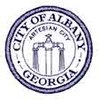Albany, GA
| Albany, Georgia | ||
|---|---|---|
| City | ||

The Albany Government Center
|
||
|
||
| Nickname(s): The Good Life City, The Artesian City, Egypt Of America | ||
| Motto: "There's only one Albany, Georgia" | ||
 Location in Dougherty County and Georgia |
||
| Coordinates: 31°34′56″N 84°9′56″W / 31.58222°N 84.16556°WCoordinates: 31°34′56″N 84°9′56″W / 31.58222°N 84.16556°W | ||
| Country | United States | |
| State | Georgia | |
| County | Dougherty | |
| Incorporated (city) | December 27, 1838 | |
| Government | ||
| • Mayor | Dorothy Hubbard | |
| Area | ||
| • City | 55.9 sq mi (144.7 km2) | |
| • Land | 55.5 sq mi (144.8 km2) | |
| • Water | 0.3 sq mi (0.9 km2) | |
| Elevation | 203 ft (62 m) | |
| Population (2010) | ||
| • Density | 1,385.5/sq mi (535.0/km2) | |
| • Urban | 77,434 | |
| • Metro | 157,308 (US: 258th) | |
| Demonym(s) | Albanian | |
| Time zone | EST (UTC-5) | |
| • Summer (DST) | EDT (UTC-4) | |
| ZIP code(s) | 31701, 31705, 31707, 31721, 31763 | |
| Area code(s) | 229 | |
| FIPS code | 13-01052 | |
| GNIS feature ID | 0310424 | |
| Website | albany.ga.us | |
|
East Albany District, Albany, Ga East Albany |
|
|---|---|
| District | |
| Coordinates: 31°35′00″N 84°07′50″W / 31.58333°N 84.13056°W | |
| Country | United States |
| State | Georgia |
| County | Dougherty |
| Elevation | 203 ft (62 m) |
| Time zone | Eastern (EST) (UTC-5) |
| • Summer (DST) | EDT (UTC-4) |
| ZIP code | 31705 |
| Area code(s) | 229 |
Albany is a city in the U.S. state of Georgia, and is the seat of Dougherty County. Located in southwest Georgia, it is the principal city of the Albany, Georgia metropolitan area. The population was 77,434 at the 2010 U.S. Census, making it the eighth-largest city in the state.
The area where Albany is located was formerly inhabited by the Creek Indians, who called it Thronateeska after their word for "flint" because of the mineral flint that was found near the river. The Creeks used this flintstone to make tools and weapons such as arrowheads.
American settlement began with Nelson Tift, from Groton, Connecticut, who took land along the Flint River in October 1836 after Indian removal. The Creek were forced to relocate to Indian Territory west of the Mississippi River. Tift named his new town Albany after the capital of New York; both were located at the navigable heads of rivers. Alexander Shotwell laid out the town in 1836. It was incorporated as a city by an act of the General Assembly of Georgia on December 27, 1838.
Tift for decades was the city's leading entrepreneur. An ardent booster, he promoted education, business, and railroad construction. During the Civil War he provided naval supplies and helped build two ships. He opposed Radical Reconstruction inside the state and in Congress, and was scornful of the Yankee carpetbaggers who came in. John Fair concludes that Tift became "more Southern than many natives." His pro-slavery attitudes before the war and his support for segregation afterward made him compatible with Georgia's white elite.
The area was developed by planters using slave labor for clearing land and cotton cultivation. By 1840, Dougherty County's majority population was black, composed overwhelmingly of slaves. The market center for cotton plantations, Albany was in a prime location for shipping cotton to markets by steamboats on the river. In 1858, Tift hired Horace King, a former slave and bridge builder, to construct a toll bridge over the river. King's bridge toll house still stands.
...
Wikipedia

